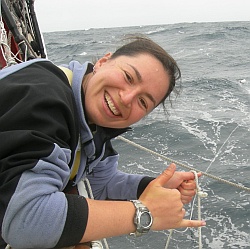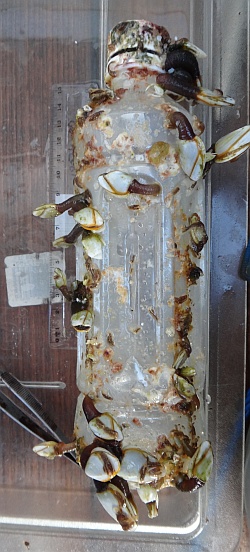Today’s ‘Interview with an Author’ is a Two for One! We spoke with Drs Miriam Goldstein and Deborah Goodwin, co authors on the recent PeerJ article “Gooseneck barnacles (Lepas spp.) ingest microplastic debris in the North Pacific Subtropical Gyre”, which received quite a bit of attention in the press. We were very interested in hearing more about their work and their experience with us.
PJ: Can you tell us a bit about yourself?

MG: I did my Ph.D. work at Scripps Institution of Oceanography at the University of California, San Diego. My dissertation focused on the ecological consequences of plastic pollution in the North Pacific Subtropical Gyre. I am currently a Knauss Marine Policy Fellow in Washington DC.

DG: I am an Assistant Professor of Oceanography at Sea Education Association (SEA). We are based in Woods Hole, MA, but I spend most of my time teaching undergraduate students while traveling the Atlantic and Pacific Oceans onboard our sailing research vessels. I completed my Ph.D. at the University of New Hampshire, with research in satellite remote sensing of phytoplankton health and an outreach focus on interdisciplinary marine science education.
PJ: Can you tell us about plastic pollution and the research you published with us?

DG: Scientists have studied floating plastic debris in the world’s oceans for multiple decades and have observed that plastic pollution is widespread across all basins. The greatest accumulations occur in the subtropical convergence zones, such as the North Pacific Subtropical Gyre from which this project’s samples were gathered. Well-recognized effects of marine plastic pollution include harm to animals from ingestion and entanglement, transport of non-native species to new locations, and addition of chemicals into seawater. Recently, much research has shifted focus from large debris objects (such as those upon which our barnacles were living) to microplastic particles less than 5mm in size (like the ones our barnacles were ingesting) – with this shift has come an increased consideration of plastic pollution’s potential impacts on smaller marine organisms as well as interactions with microbes and bacteria. While a substantial number of projects have investigated aspects of marine debris, major questions remain with regards to the overall quantity, distribution and fate of plastics in the ocean so there is a lot still to study!
SEA, the organization for which I work, has been collecting data about marine plastic pollution for over 40 years. Using a surface zooplankton net, we have taken samples twice daily on annually repeated cruise tracks across portions of the Caribbean Sea, northwestern Atlantic, and eastern Pacific Oceans that are rarely studied in such a consistent manner by other ship-based research efforts. As a result, we have built a pretty unique time series data set that allows us to ask questions about how the abundance, distribution and characteristics of plastic pollution change both spatially and temporally. Furthermore, we look for opportunities to explore current marine environmental issues through field work – this collaboration offered the chance to deepen our understanding of the impacts of marine debris in a very tangible way and really caught the attention and enthusiasm of our students.
MG: I collected some barnacles on a 2009 cruise to the North Pacific Subtropical Gyre, but I was more interested in what species were there. When I was dissecting them in the lab in order to identify the species, I decided to take a look inside their stomach just for fun. As soon as I cut open the first barnacle, a bright blue piece of plastic popped out. So I contacted Deb, and asked her and SEA to collect more barnacles, so we could see how widespread this issue might be. This paper is a result of that collaboration.
PJ: What challenges did you face while doing this research?
MG: Mostly finding time to do it, since neither of us is currently doing research as our primary job. We were fortunate to have SEA’s support in both collecting samples and allowing us to use their equipment on their campus in Woods Hole.
PJ: You discovered that gooseneck barnacles are eating plastic. Did you find anything else surprising or unexpected while conducting your research?
DG: While doing the dissections, I was surprised at just how many plastic particles were in some of the gut tracts. Once we started, I anticipated finding a few but those individuals with 15 to 30 particles were definitely unexpected.
MG: This isn’t in the paper, but along with plastic, the barnacles are eating a lot of their own offspring. Their guts were often filled with cyprid larvae.
PJ: What kind of plastic did you find in their guts, and where do you think it is from?

MG: The plastic was primarily polyethylene and polypropylene. These are the most common kinds of plastic that float. The plastic we found in the barnacles is approximately representative of the plastic that’s floating on the surface of the ocean – they’re probably just grabbing what is there. We don’t know specifically where the plastic came from, or what objects they might have been before they degraded into tiny particles, but we certainly do know that plastic does not belong in the ocean.
PJ: Do larger predators eat gooseneck barnacles? Does that mean that they are introducing plastic into the food chain?
MG: A few predators –a slug and some crabs – eat them but fish don’t seem that interested in barnacles, perhaps because those fish didn’t evolve with a ton of floating debris. If barnacles are an important prey item, it is possible that their ingestion of plastic particles could transfer plastic or pollutants through the food web, but we don’t know if this is actually happening. There’s a lot of research going on right now to figure out what effects of plastic might be on the food web.
PJ: Where do you hope to go from here? What is next in your research?
MG: I’m not doing any new research at the moment, since I’m working in policy. But if I do continue this research (or if someone else is interested in doing so), I think it’s really important to figure out how the attached fouling organisms, like the barnacles, are interacting with the larger open ocean ecosystem. That’s key to figuring out what the true ecological impact of plastic might be.
DG: SEA faculty scientists have published several papers based on our marine plastic pollution data archive. We are also currently examining the microbial communities living on plastic debris, selective grazing of microplastic particles by zooplankton, and physical/chemical weathering of plastics in the marine environment. As for myself, I am in the midst of efforts looking at temporal and spatial patterns and variability in marine debris abundance as well as Sargassum distribution, a macroalgae unique to the Sargasso Sea in the central North Atlantic. Both draw upon SEA’s cruise long-term datasets and connect to real-world scientific issues we observe and explore during our student-focused research voyages.
PJ: What is the audience that you wish to reach publishing with us, and what kinds of lessons do you hope the public takes away from your findings?
DG: I work mostly with college students who often have a difficult time getting access to full-text articles from many journals. I’m interested in our research findings being available to anyone who wants to read about them. In terms of a larger message, I would like readers to appreciate that marine pollution is an issue with significant ecological implications even if most of the ocean is out of sight, far offshore, or below the sea surface.
MG: The public is extremely concerned about plastic in the ocean. While our paper is written for a scientific audience, we hope that it’s accessible to interested members of the general public as well. We hope that our work will spur increased interest in preventing plastic from entering the ocean in the first place.
PJ: How did you first hear about PeerJ, and what persuaded you to submit to us?
MG: I heard about PeerJ at the Science Online conference, and was excited to learn that there was an affordable Open Access journal that was also encouraging open peer review. Since the public is so interested in oceanic plastic pollution, it’s very important to me to make my research available to anyone who is interested. The submission and review process was straightforward and helpful, and I’m very pleased with the overall PeerJ experience.
DG: I heard about PeerJ from Miriam when she suggested it as appropriate for this collaboration. When I looked into it, I liked what I found so agreed to submit here.
PJ: PeerJ encourages Authors to make their review comments visible. Why did you choose to reproduce the complete peer-review history of your article?
MG: I really like being able to publish the peer review history. It gave us the opportunity to explain some choices we made in the paper to anyone who is interested. If people have questions about why we did one thing and didn’t do another thing, I can encourage them to look at the peer review history, where many of those questions are answered.
PJ: Would you submit again, and would you recommend that your colleagues submit?
MG: I would definitely submit to PeerJ again, and have already recommended to colleagues that they do so. My only concern is that PeerJ is not currently indexed in Web of Science, but I understand that you’re working on that [Ed Note: Correct!].
PJ: Many thanks!
If you would like to experience the future of publishing for yourself, then submit now to PeerJ. And don’t forget we are running a special Free Publication offer until the end of 2013!

